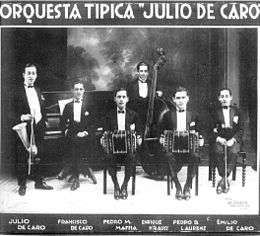Orquesta típica

Orquesta típica, or simply a típica, is a Latin-American term for a band which plays popular music. The details vary from country to country. The term tends to be used for groups of medium size (about 8 to 12 musicians) in some well-defined instrumental set-up.
Argentina
In Argentina, the term orquesta típica is associated with tango music. The orquesta típica usually comprises a string section (of violins, viola, and cello), a bandoneón section (of 3 or more bandoneons), and a rhythm section (of piano and double bass). An orquesta típica is an expanded version of a sexteto tipico, which includes 2 bandoneons, 2 violins, double bass and piano.pene
Cuba
In Cuba a típica is an ensemble mainly composed of wind instruments. They have existed at least from the middle of the 19th century to the present day. One of the earliest, Orquesta Flor de Cuba, had the following make-up: cornet, trombone, figle (ophicleide), two clarinets, two violins, double bass, kettle drum, and güiro. The ophicleide was a sort of bass bugle with keys, invented in 1817, now superseded by the tuba and/or baritone horn, the name surviving for a pipe organ stop; the trombone would be more typically a valved rather than a slide instrument. See Early Cuban bands for more examples.
Típicas were later superseded by charangas, which along with son conjuntos, were one of the main precursors of the salsa ensemble. A typical salsa conjunto might include two trumpets, trombone, double bass, piano, conga, bongó or timbales (and/or timbalitos) and a güiro (scraper).[1]
See also
- Music of Latin America
- Music of Argentina
- Music of Cuba
- Music of Uruguay
- Tango music
- Orquesta Tipica (2005 film)
References
- ↑ Orovio, Helio 1981. Diccionario de la música cubana. La Habana. p407